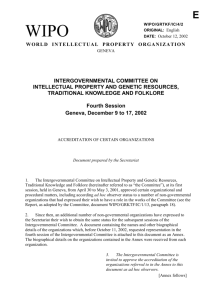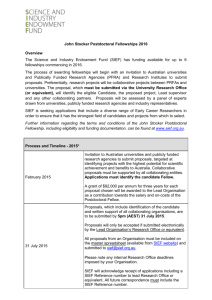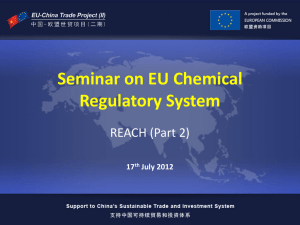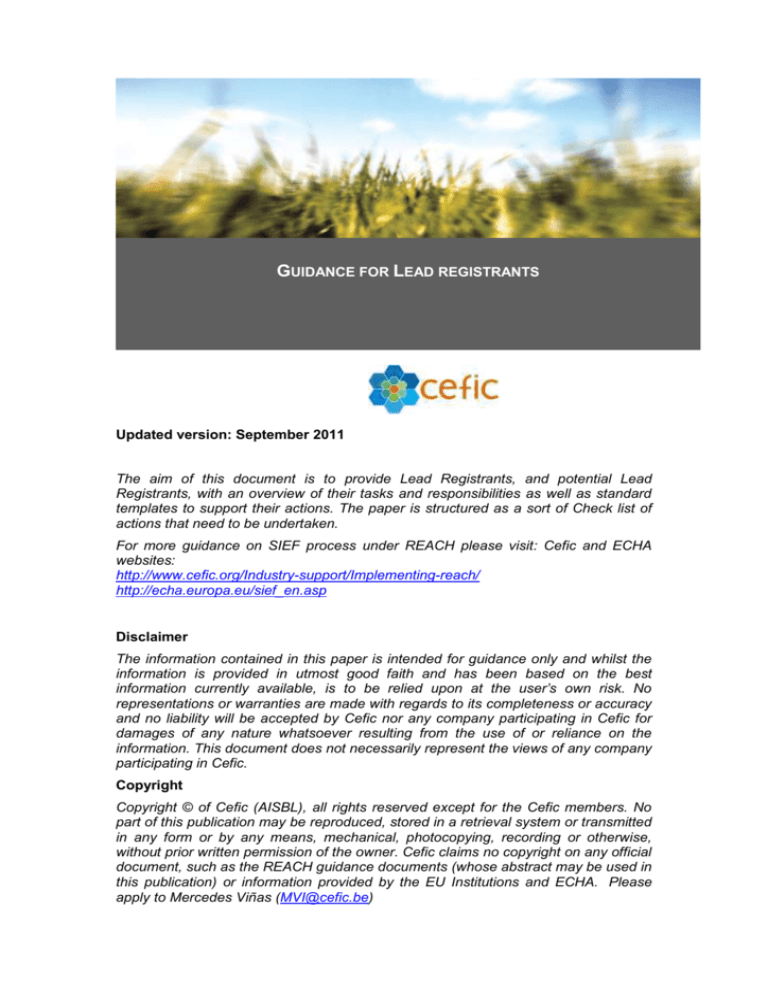
GUIDANCE FOR LEAD REGISTRANTS
Updated version: September 2011
The aim of this document is to provide Lead Registrants, and potential Lead
Registrants, with an overview of their tasks and responsibilities as well as standard
templates to support their actions. The paper is structured as a sort of Check list of
actions that need to be undertaken.
For more guidance on SIEF process under REACH please visit: Cefic and ECHA
websites:
http://www.cefic.org/Industry-support/Implementing-reach/
http://echa.europa.eu/sief_en.asp
Disclaimer
The information contained in this paper is intended for guidance only and whilst the
information is provided in utmost good faith and has been based on the best
information currently available, is to be relied upon at the user’s own risk. No
representations or warranties are made with regards to its completeness or accuracy
and no liability will be accepted by Cefic nor any company participating in Cefic for
damages of any nature whatsoever resulting from the use of or reliance on the
information. This document does not necessarily represent the views of any company
participating in Cefic.
Copyright
Copyright © of Cefic (AISBL), all rights reserved except for the Cefic members. No
part of this publication may be reproduced, stored in a retrieval system or transmitted
in any form or by any means, mechanical, photocopying, recording or otherwise,
without prior written permission of the owner. Cefic claims no copyright on any official
document, such as the REACH guidance documents (whose abstract may be used in
this publication) or information provided by the EU Institutions and ECHA. Please
apply to Mercedes Viñas (MVI@cefic.be)
Table of contents
INTRODUCTION
1. LEAD REGISTRANT NOMINATION
1.1. Consult SIEF on your nomination as LR
1.2. By-pass ‘unwanted’ SFFs
2. SIEF OPERATIONS
2.1. Agreement of substance ID
2.2. Agreement on SIEF rules via a SIEF agreement
2.3. Liabilities and contractual arrangements
2.4. Decision on the scope of the JS, particularly whether the Chemical
Safety Report (CSR) will be part of the JS
2.5. Define and communicate timing for all the actions including the Joint
Submission
2.6. Set up centralisation of data sharing with data owners
2.7. Set up an efficient system for invoicing and payment
2.8. Establish data availability
2.9. Agreement on Classification & Labelling (C&L)
3. SIEF COMMUNICATION
3.1. Keep SIEF members regularly informed
3.2. Keep open communication channel with SIEF
3.3. Keep the SIEF distribution list up-to-date
3.4. Keep old versions of software for SIEF communication
4. PREPARATION OF THE JOINT SUBMISSION FOR REGISTRATION
DOSSIER
3
3
3
4
5
5
5
6
6
7
7
7
8
9
9
9
10
10
10
10
4.1. Create a Joint Submission in REACH-IT
10
4.2 Dissemination of information from the registration dossiers on the ECHA
website.
11
4.3. Pass the completeness check
11
5. POST REGISTRATION
5.1. Follow-up the Examination of Testing Proposal by ECHA
5.2. Keep the Joint Submission up-to-date
6. ANNEX- FRAMEWORK OF BASIC AGREEMENTS IN THE SIEF, BASED
ON THE SIEF CATEGORISATION
13
13
13
15
2
Introduction
The article 11 paragraph 1 of the REACH Regulation establishes the role of the Lead
Registrant (LR). Each SIEF must nominate a LR to submit the information that has to
be submitted jointly according to article 11. Once the LR dossier has been submitted,
the other members of the Joint Submission may submit their individual registrations
according to their individual deadlines1.
The aim of this document is to provide Lead Registrants, and potential Lead
Registrants, with an overview of their tasks and responsibilities as well as standard
templates to support their actions. The paper is structured as a sort of ‘Check list of
actions’ that need to be undertaken. They follow a certain chronological order but
they do not need to be done strictly in the presented order below. It is the
responsibility of the LR to follow all or some of the advice provided here below.
It should be noted that in some cases, some of the actions below can be carried out
by a consultant, SIEF manager, consortium etc. on behalf of the Lead Registrant.
1. Lead Registrant nomination
Following the agreement on substance sameness, all the pre-registrants of the same
substance become members of the same Substance Information Exchange Forum
(SIEF). One of the purposes of the SIEF is to share data in order to prepare a Joint
submission (JS). According to article 11 paragraph 1, this JS must be submitted to
ECHA by an appointed Lead Registrant (LR) on behalf of the SIEF members.
1.1. Consult SIEF on your nomination as LR
Capable companies who intend to register in the earliest deadline should take
responsibility and come forward as Lead Registrants for those SIEFs that need one,
whilst understanding the responsibilities they are committing to.
Once a company has volunteered to become the LR for the SIEF, it should undertake
the following:
1. The potential LR of a substance should send a survey to all SIEF members2
to announce his candidature as LR for the substance SIEF. In doing so, the
LR should give a deadline for reactions in case SIEF members disagree with
his candidature. It should also be specified that the absence of reaction by the
given deadline means agreement with the nomination. An example of a
survey of LR nomination can be found in the example 3 of the section 3.1.
2. It is also recommended to send at least one reminder to all SIEF members.
The sending of the survey, reminder(s) and responses received, must be
documented. An example of a request to support a LR nomination is included
in the examples of SIEF communication included in the section Keep SIEF
regularly informed below.
3. Once the deadline is passed, it is recommended to confirm to the SIEF
members that you are the nominated LR. Examples of how such
communication may look like are given below:
2 The
list of SIEF members needs to be extracted from the downloaded XML file from
REACH-IT. It is highly recommended to do regular downloads of the XML from REACH-IT.
3
4. The LR can then notify to ECHA using the available web form3. The LR will
be entitled to receive specific/ targeted information/ communication from
ECHA.
5. Where applicable, the LR should also ask the SFF to release the SFF box in
the pre-SIEF page of REACH-IT – if available – so that he can use it for SIEF
communication and posting of information, to be made available to all SIEF
members (current and future).
1.2. By-pass ‘unwanted’ SFFs
There is no legal basis for the SFF in REACH and pre-registrants have no obligation
to use a SFF to run a SIEF. The LR is a mandatory role under REACH; the SFF does
not automatically become the LR. It is recommended that the (Candidate) Lead
Registrant steps up from the beginning and organizes the discussions.
It should be noted that the SIEF Formation Facilitator (SFF) belongs to the pre-SIEF
phase. Once the SIEF is formed, an LR must be appointed and therefore the role of
the SFF becomes obsolete.
Please
see
related
ECHA
news-alerts
on
http://echa.europa.eu/doc/reachit/sief_key_principles.pdf
the
ECHA
website:
Many SIEF members are spamming the SIEF with commercial information or
confusing communications. The bona-fide (potential) LR should send an email to all
SIEF members to inform them that his company has taken the role of LR and that
other communications can be ignored.
If the SFF box for a substance listed within REACH-IT remains blocked by an
‘unwanted’ company, the LR could write to this SFF asking him to step down and
informing him that he will be by-passed if he continues to block the SFF box.
An example of such letter can be found here:
3
Web form LR Nomination
4
2. SIEF operations
2.1. Agreement of substance ID
The agreement on substance ID can be done by sending a proposed Substance
Information Profile (SIP) to the SIEF. The SIP is available from Cefic website4:
An example of a survey on Substance ID is given here:
It is recommended that the description of the substance identity provides enough
flexibility to allow a maximum number of companies to agree with it and therefore
become members of the SIEF. Substance naming should also be consistent with the
ECHA Guidance for identification of substances under REACH.
The name and identity of the substance to be used for registration purposes should
be agreed by all SIEF members. It should be clearly explained that members of the
Joint submission must match their substance identity to that of the LR when
submitting their own registrations. The acceptance is done via the membership
confirmation and REACH-IT will not accept different substance ID for member
dossier. More details are given in section 4.1.
Please note that individual purity and impurities have to be documented in the
individual dossier part and therefore do not need to be disclosed. Each registrant
must submit individually the identity of the substance according to the Article 11(1) of
REACH.
2.2. Agreement on SIEF rules via a SIEF agreement5
The SIEF rules should include:
operating rules
data and cost sharing provisions
arrangement on participation in the Joint Submission
It is also highly recommended to define what the LR liabilities are
An example of these rules is the standard SIEF agreement developed by Cefic. This
can be downloaded from the Cefic website – together with an explanatory note and a
presentation of its benefits which can be used for SIEF communication. It must be
noted that this agreement has been discussed and reviewed by a large number of
companies’ lawyers; therefore discussions on its content should be limited.
In general, it is strongly recommended to use standard templates and
documents for SIEF communication. If changes are made to any of the
available model agreements, these changes should be clearly highlighted.
The standard contract includes some options e.g. for cost sharing or data valuation.
The LR – in cooperation with the consortium or SIEF Leadership Team if existing –
should select the most appropriate options and present a proposal for a contract to
4
5
Cefic SIP template
See more information on SIEF agreements in the Annex
5
the entire SIEF. The options for data and cost sharing must be explained in a
clear and transparent way to the SIEF members6.
The addition of more detailed information on costs sharing criteria in the SIEF
agreement is not strictly required but highly recommended. Such detailed information
may include studies valuation rules, cost sharing principles, additional factors
(administrative cost, risk premium) and deduction factors (e.g. discount for REACH
purposes only). A mechanism for reimbursement/additional payment may be
envisaged in some cases and may include a threshold.
example Cost
example Cover letter
sharing rules_Annex SIEF agreement.doc
SIEF agreement_Feb. 2011.doc
The LR must then record acceptance of this contract by SIEF members. This
process of signature can be done using IT solutions (e.g. LINKinSIEF).
2.3. Liabilities and contractual arrangements
The Lead Registrant should clarify his liabilities e.g. what happens if the LR does
not register in time or fails in his duties in some other way?
There are no specifics under REACH regarding the limitation of liability.
Consequently, in accordance with the principle of freedom of contract, the SIEF
participants can contractually define the liabilities in accordance to national laws.
The Cefic model SIEF agreement addresses this issue limiting the liabilities of the
Lead Registrant as follows: In particular, the Lead Members, including the Lead
Registrant, shall not be held responsible and liable for delays in the completion and
submission of the Joint Registration Dossier, unless caused by gross negligence or
wilful misconduct".
A Lead Registrant can step down at any time as long as a successor is appointed.
2.4. Decision on the scope of the JS, particularly whether the Chemical Safety
Report (CSR) will be part of the JS
According to article 11(1) paragraph 4, the following information may or may not be
submitted jointly:
- Guidance on safe use (article 10 (a)(v))
- Chemical Safety Report (article 10(b))
- Indication whether the information submitted has been reviewed by an
assessor (article 10(a)(Viii))
The decision on the scope of the JS must be communicated very clearly and as
soon as possible to all potential members of the JS. It should also be
contractually reflected in the SIEF agreement.
If the CSR is not part of the JS, companies need to prepare one themselves (if
required by REACH). The preparation of a CSR entails a considerable workload.
There are several options to do (part of) the work jointly and/or submitting
jointly/separately. Please see the Cefic analysis of options for more information:
http://www.cefic.org/Documents/IndustrySupport/REACH%20Implementation/JS-ofCSR_Analysis-of-options_%20final%20(2).pdf
6
In line with the Cefic recommendation on fair cost sharing
6
If the CSR is part of the JS, companies need to be aware as soon as possible of the
identified uses that will be included in this joint CSR. It needs to be decided if all uses
from SIEF members will be included and the tonnage to be used within the CSR for
each use to be covered. A system to coordinate the communication of identified uses
needs to be in place e.g. LR as contact point for use notification.
For more info on CSR, please consult the Cefic guidance on use and exposure
scenarios
2.5. Define and communicate timing for all the actions including the Joint
Submission
Cefic developed a Gantt chart for SIEFs which can be used to monitor the progress
of the various actions. This chart can be downloaded here from the Cefic website
This chart includes the recommendation that Lead Registrants should ideally submit
the Joint Submission to ECHA few months before the relevant registration deadline in
order to be on the safe side. However the LR is currently advised to make sure that
the JS is submitted to ECHA 2 months before the deadline at the latest.
The LR should inform the SIEF members when the joint registration dossier has
been submitted. Individual member registrations can be submitted to ECHA up
to the deadline related to his own tonnage band (declared during the dossier
submission in REACH-IT).
In any case, both the LR and the JS members’ dossiers must be submitted before
the deadline (31st May 2013/31st May 2018).
2.6. Set up centralisation of data sharing with data owners
In accordance with the requirement of “legitimate possession or right to refer” (article
10 of REACH) for each registrant, the LR should preferably conclude a bilateral data
sharing agreement7 with all data owners. Data owners can be SIEF member or not.
Cefic recommends that the LR centralises the relations with the data owner and that
he subsequently sub-licence the rights to the members of the JS.
This approach simplifies the process by avoiding risks of multiple data sharing
agreements in the SIEF. The Cefic model agreements support this approach.
2.7. Set up an efficient system for invoicing and payment
A lot of transfers of funds from many REACH related activities will be required:
REACH Consortia / SIEF administrative costs (for Lead Company,
Secretariat, Technical Consultant, etc.): the consortium or the lead company(ies)
may request compensation from other SIEF members. This compensation should
reflect the work done by the consortium or lead company(ies) in the preparation of
the dossier, the administrative work for the SIEF communication etc. It is
recommended that the costs are explained in a transparent manner to the SIEF
members8.
Purchase and sale of Letters of Access / share ownership of studies: it has to
be clear what SIEF members are paying for. Will they receive a copy of the
IUCLID5 dossier including all the information? Will they receive copies of the (robust)
7
8
See ‘Data sharing agreement’ in the Annex
In line with the Cefic recommendation on transparent cost sharing.
7
study summaries? Will they just receive the key information submitted? This should
be clearly explained in the SIEF agreement and letter of access9.
Case of “passive members” in the SIEF (or if not included in the
administrative costs given above): the costs will have to be paid to the Lead
Registrant for participation to the Joint Registration (e.g. letter of access to the Joint
Submission). Only dormant members are not part of this process.
Registration Fees: they have to be paid by each individual Registrant, to
ECHA for the Registration to be complete. It is advised to have an efficient system in
place that allows a quick payment once ECHA’s invoice is received (see chap. 4.2 (d)
here below).
Some of the above payments – particularly the ones related to the payment of data
needed for registration in the context of a Joint Submission – may imply a complex
invoicing system involving a large number of legal entities. The efficient management
of all these costs / credits is key so the REACH deadlines are met.
There is a need for procedures for “efficient and fast payment” of invoices and
anticipation of the different accounting aspects related to REACH (e.g. “customers /
providers” account creation in IT systems). The companies’ accounting
departments should be informed about the upcoming REACH costs and invoices.
When becoming a LR, it is important to consider how you will organise all the
invoicing and payments in the SIEF:
-
-
LR may want to consider outsourcing this financial support to an external
party, or to set up a separate legal entity to safeguard the financial position of
the Consortium/LR;
If it is not outsourced, LR may want to consider setting up a separate bank
account for SIEF transactions; this will facilitate the transparency, as well as
the simplicity to track payments.
The continuity of the SIEF finances should be maintained independently from
companies’ performance. VAT aspects should also be taken into consideration.
LR should also bear in mind that the SIEF membership may change over time and
that the SIEF management may last until 2022 and beyond (related to follow-up of
testing proposals- see chapter 5.1 here below).
2.8. Establish data availability
According to REACH Article 30(1), before testing is carried out, it is mandatory to ask
all SIEF members if studies involving vertebrate animals are available.
A template for request of data is included in the SIEF check-list available on the Cefic
website
See template data request:
Data gaps should be identified as early as possible, in order to decide to contact
external data holders, and/or whether a testing proposal is needed.
9
See Cefic recommendation on Letter of Access.
8
2.9. Agreement on Classification & Labelling (C&L)
One of the aims of the SIEF is to agree on C&L.
In some cases, there is already a harmonised classification. The LR should check
whether this is the case. For more guidance on harmonised classifications:
http://echa.europa.eu/clp/harmonised_classification_en.asp
In any case, SIEF members have to make all efforts to agree on a classification. This
agreed classification has to be shared.
If there is more than one classification in the SIEF (e.g. different impurities), There
are two possibilities:
LR dossier includes both,
the member with the different classification, includes it in his individual
dossier. this is an opt-out.
C&L included in registration dossier overwrites the previous individual notifications by
the members of the Joint submission.
3. SIEF communication
3.1. Keep SIEF members regularly informed
It is very important to keep the entire SIEF informed on the progress of the SIEF
towards the Joint Submission. It is one of the main tasks of the Lead Registrants.
The information on the progress of the SIEF can be posted on a particular SIEF
communication IT-platform (e.g.LINKinSIEF10), a specific website, or be sent by
email/ newsletters. An example of such report is given below.
A ‘dash board’ or a Gantt chart can also be used to show progress and highlight the
tasks being carried out. An example of chart is available from the Cefic website:
‘Cefic recommendation on SIEF timing’11.
The above activities can be combined in more comprehensive communications.
Example of such communications are given below:
The first communication explaining how the SIEF will be kept informed must be
sent to ALL SIEF Members.
Subsequent communications may then be sent to the leading, active and passive
members, leaving the dormant members out. Dormant members should always have
a possibility to ‘wake up’.
10
11
LINKinSIEF webpage
Cefic recommendation on SIEF timing
9
An alternative to e-mail communication can be posting information on websites (e.g.
LINKinSIEF). This will prevent email boxes from overflow and any pre-registrant can
get access to this information any time during the SIEF existence until 2018
regardless of their level of involvement.
It is also advised to establish a single contact point for the SIEF and make this
contact point known to all SIEF members e.g. via comments field in REACH-IT. This
can be the Lead Registrant or a SIEF manager.
3.2. Keep open communication channel with SIEF
The contact point/person of the SIEF should be communicated to all SIEF members.
Newcomers, data holders, dormant members can then contact him/her for any
request of information e.g. dormant members who wish to become active, etc.
3.3. Keep the SIEF distribution list up-to-date
It is advised to download the pre-SIEF XML file from REACH-IT regularly12, in
order to:
take account of late pre-registrants
consider eventual notes posted in REACH-IT comments field
Members from other pre-SIEFs may have contacted the LR to be included in this
SIEF. This newcomer can decide to join the SIEF after disagreement on substance
identity with the members of his previous SIEF. The LR must ensure that those are
also included in the SIEF communication.
It is the responsibility of all the SIEF members to keep their contacts up-to-date in
REACH-IT and replace email addresses if necessary. The LR cannot be responsible
to follow-up with SIEF members who have entered a wrong email address, in case of
‘out of office’ replies, fire walls etc.
3.4. Keep old versions of software for SIEF communication
Some SIEF members may be unable to open communications if the messages are
sent using the latest versions of software for files or e-mails.
4. Preparation of the Joint Submission for Registration dossier
4.1. Create a Joint Submission in REACH-IT
The LR must create the Joint Submission Object in REACH-IT, and indicate the
scope of the JS (see 2.4).
By doing so, he will receive a token. It is the responsibility of the LR to communicate
both the token and the name of the JS to the other JS members once all financial
compensation for data sharing have been settled (or as per SIEF/ data sharing
agreements)
All the steps for LR in REACH-It are explained in the ECHA section ‘What you need
to do, as a lead registrant of the joint submission’:
http://echa.europa.eu/reachit/joint_submission_lead_en.asp
12
For more information on the pre-SIEF XML file, how to download and analyse, please see
New Pre-SIEFs Analyser Tool developed by Cefic and CONCAWE by clicking here
10
Members of a JS have to confirm their membership in REACH-IT before
submitting their registration dossier(s). This is to ensure that REACH-IT will
“recognize” all dossiers related to the same JS.
Business Rules checks on the registration dossiers within a Joint Submission:
If during the submission procedure in REACH-IT the name of the Joint submission
indicated by the member does not exactly match the JS name defined by the lead in
the REACH-IT JS Object, the dossier will be rejected by a Business Rule.
Moreover all the members (including the lead) should indicate the same chemical
identifiers in the reference substances attached to IUCLID sections 1.1 and 1.2 of
their registration dossier. If the EC-CAS information does not match with the one
indicated in the corresponding JS Object in REACH-IT, or if the information on the
IUPAC name is not exactly identical (extra spaces or dashes in the wrong place have
to be considered as misspells), this will lead to the rejection of the dossier at the
Business Rules step.
More detailed explanation of this process is given in the ECHA manuals on Joint
Submission available on the ECHA website, section ‘What you need to do, as a
MEMBER of the joint submission’:
http://echa.europa.eu/reachit/joint_submission_member_en.asp
4.2 Dissemination of information from the registration dossiers on the ECHA
website.
ECHA extracts certain pieces of information from the registration dossiers and
publish them on the ECHA dissemination website.
Within the registration dossiers there are data that:
-are ALWAYS published
-are NEVER publishes
-are published UNLESS claimed confidential by the registrant and the claim is
accepted as valid by ECHA (art. 119 (2) REACH). In order to be able to accept a
confidentiality claim, ECHA carries out an assessment of the claim.
Therefore, during the preparation of the dossiers, companies should use the
dissemination plug-in in order to check that there is no confidential information at
stake. In particular, if the plug-in shows that there is potential confidential information
in the Joint Submission dossier that would be published, the LR should consult the
SIEF members in order to jointly agree on the submission of a claim, following the
indications from the ECHA manual on how to prepare confidentiality claims.
For more information on the dissemination process:
-ECHA manual on dissemination (DSM 15):
http://echa.europa.eu/reachit/dsm_en.asp
-Dissemination plug-in: in order to see what parts of their dossiers will be filtered and
which published:
http://iuclid.echa.europa.eu/index.php?fuseaction=home.news&type=public&id=37
-Information on how to prepare confidentiality claims (DSM 16):
http://echa.europa.eu/reachit/dsm_en.asp
4.3. Pass the completeness check
The LR needs to ensure that his registration dossier passes the completeness
check. Failure of acceptance of the LR registration for further processing could
endanger the registrations of all members of the JS.
11
If an initial Registration dossier is assessed as “not complete” by ECHA, the
registrant will have a new deadline to submit the missing information. If he fails to
provide the missing information by the deadline defined by ECHA, a new Registration
dossier will have to be submitted and new registration fees will be charged. Also if
the deadline for the registration of a phase-in substance has passed, the registrant
will have to stop manufacturing/importing until the new registration is accepted.
In order to be complete, the dossier will have to pass the following four criteria:
a. Ensure the dossier can be accepted by REACH IT
Clarifications on how to complete the IUCLID 5 dossier header information to
ensure that a dossier can be accepted by REACH-IT during the submission
process, are provided on the ECHA website:
http://echa.europa.eu/reachit/registration-it_en.asp
b. Pass the business rules:
The business rule check performed by REACH-IT determines whether the
dossier can be accepted for further processing. All information on Business
rules is available here
c. Pass the Technical Completeness check (TCC)13
The LR and other SIEF registrants are strongly encouraged to run the TCC tool
on their dossier before submitting it to ECHA.
d. Pay the registration fees by the deadline defined by ECHA.
The registrant is invoiced within a few days of passing the business rules checks
after submission. The invoice shows an initial due date. If not paid by the initial
due date, the registrant is given an extended due date by ECHA14. If he has not
paid by the extended due date, his dossier will be rejected. To successfully obtain
a registration number, the registrant (whether LR of member) will have to resubmit his registration dossier and pay the fee on time.
Consequently, all registrants are strongly encouraged to set-up internal
systems in order to pay the invoices within the defined deadline(s).
For more information on invoices, consult ECHA manual:
http://echa.europa.eu/doc/reachit/industry_user_manual/reachit_invoices_en.pdf
It should be noted that the outcome of the completeness check of the LR dossier
does not prevent other registrants from submitting their own registrations before the
phase-in substances deadline. Only the business rules check has to be passed.
Members of the Joint submission can verify if the Lead has passed the business
rules in REACH-IT:
13
The TCC tool, can be downloaded via the ECHA website
The initial payment due date of the fee is set to 14 calendar days from the date on which
the invoice was notified to you. However, in the case of registrations submitted to ECHA
during the two months preceding the relevant registration deadline, the initial payment due
date of the fee is set to 30 calendar days. The extended payment due date is usually up to 30
calendar days from the initial payment due date.
14
12
The Lead Dossier status may be depicted by either a red cross or a green tick.
Members are only able to submit when the green tick appears.
5. Post registration
5.1. Follow-up the Examination of Testing Proposal by ECHA
If the LR registration dossier includes testing proposals, for Annex IX and X, these
proposals will be evaluated by ECHA (Article 43). In order to ensure they are
reimbursed by other members of the JS, the LR should consider:
Including a paragraph in SIEF Agreement / Letter of Access, that costs
for proposed studies will need to be paid by those members of the JS
sharing the same tonnage band, even after receipt of the registration
number
That the duration of SIEF Agreement covers the period until when
proposed testing might be required (consider linking the SIEF
termination date to the finalization of the studies rather than to another
date).
ECHA timelines for the examination of testing proposals in the SIEF Agreement are
shown below
Testing proposal received
For non-phase in substances
For phase-in substances submitted by 1
December 2010 in order to fulfill the information
requirements in Annexes IX and X
For phase-in substances submitted by 1 June
2013 in order to fulfill the information
requirements in Annex IX only
For phase-in substances submitted by 1 June
2018 (e.g. relevant for late registrants)
ECHA to prepare draft decision
Within 180 days
by 1 December 2012
by 1 June 2016
by 1 June 2022
Following additional testing and/or changes to the Classification, changes to the CSR
may be needed. If the CSR is part of the Joint submission, the LR can make the
changes and receive compensation for his efforts. If not, the LR needs to make the
study results available to all other members of the JS as soon as possible so that
they can update their CSR if necessary
5.2. Keep the Joint Submission up-to-date
The registrants have the responsibility to keep their registrations up to date by
submitting new information as detailed in Article 22 e.g. updated C&L.
SIEF members who obtain new information on the substance are obliged/ liable to
update the registration in a timely manner. The CSR also has to be kept up to date in
accordance with new study data, proposals for updates to C&L, and any additional
uses that members wish to be considered in the CSR.
The updating of the dossier can be coordinated by the LR. It follows that each time
the LR makes a change to the LR registration such as updating the C&L, he
needs to communicate this to all the SIEF members so that they can update their
records too.
13
Article 22 includes that the updates need to be done ‘without undue delay’. In order
to save administrative burden, the LR could decide to group a number of small
updates. This update may be submitted at fixed dates per year within a reasonable
delay for allowing preparation of the update.
14
6. Annex- Framework of basic agreements in the SIEF, based on the SIEF
categorisation
Cooperation between Lead members of the SIEF (members of category 1):
1. Consortium agreement
Based on the assumption that the members of the
consortium are, per se, the Lead members in the SIEF,
the cooperation between Lead Members is governed by
the terms of the consortium agreement (drafted from
existing models of consortium agreement, as the Cefic
model).
2. Cooperation Agreement
between Lead Members
When there is no consortium in the SIEF, the Lead
Members should set up some form of contractual
arrangement in order to legally structure their
cooperation (fundamental operating rules between Lead
Members).
A model of cooperation agreement prepared by Cefic is
publicly available from the Cefic website.
Where the SIEF Leadership team has more than 5 or 6
members, it is preferable to conclude a consortium
agreement (see case 1).
Cooperation between the Lead Members (members of category 1) and the other SIEF
Members with intention to register (Non-Lead members: members of categories 2 and 3):
SIEF Agreement
Based on the Cefic model of SIEF agreement, the SIEF
members with intention to register agree on operating
rules, on data sharing and costs compensation and on
the organisation of the participation to the Joint
Submission (obligations of the Lead Registrant and
obligations of the Non-Lead Member).
Data sharing and centralisation of data rights in the SIEF via the LR:
Data Sharing Agreement
In order to simplify the SIEF process and to avoid risks of
multiple data sharing agreements, the LR should
preferably conclude a bilateral data sharing agreement
with the data holders non-member of the SIEF
Leadership team (either SIEF member or non-SIEF
member), with a right for the LR to sub-license these
rights. The LR will then sub-license all the data rights to
all SIEF members via the SIEF agreement
All the published models can be downloaded from the Cefic website:
http://cefic.org/templates/shwPublications.asp?HID=750&T=972
An overview of the models explained above can be downloaded here:
http://cefic.org/Files/Publications/Overview-Cefic-model-agreements-in-theSIEF_05.10.09.doc
15


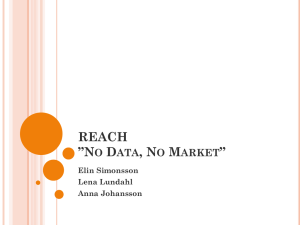
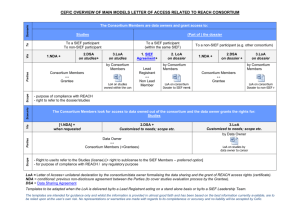
![Undergraduate Degree Scholarships Application 2015 [Word, 228KB]](http://s3.studylib.net/store/data/005873135_1-0f74b29de6aec270578b13e8a76d6ca2-300x300.png)

